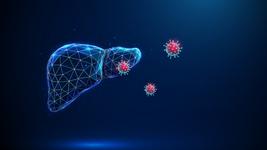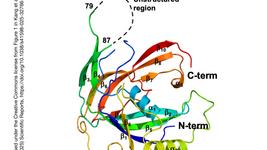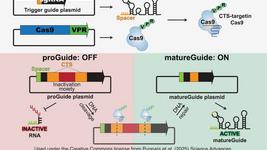CMN Weekly (12 September 2025) - Your Weekly CRISPR Medicine News
By: Gorm Palmgren - Sep. 12, 2025
Top picks
- American researchers have engineered a bespoke CRISPR-Cas9 adenine base editor to correct the ACTA2 R179H mutation that causes multisystemic smooth muscle dysfunction syndrome (MSMDS). Delivered via an AAV vector with smooth muscle tropism, the editor achieved precise correction in mice, reducing harmful bystander edits. Treatment rescued vascular, neurological, and systemic defects, and extended lifespan nearly fourfold, highlighting the therapeutic promise of mutation-specific Cas9 engineering for severe vascular diseases.
- KSQ Therapeutics has dosed the first patient in a Phase 1/2 trial of KSQ-004EX, a CRISPR-Cas9–engineered TIL therapy. KSQ-004EX inactivates SOCS1 and Regnase-1, genes identified via the company’s CRISPRomics platform as limiting TIL function. Preclinical studies showed enhanced persistence, tumour infiltration and killing. The trial will assess safety, tolerability, and early efficacy across multiple advanced solid tumour indications, including melanoma, NSCLC, CRC and pancreatic cancer.
Research
- TDAC-seq, a novel method that combines CRISPR perturbations with double-stranded DNA cytidine deaminases and long-read sequencing, enables single-nucleotide resolution mapping of chromatin accessibility along individual fibres. Applied to human CD34+ HSPCs, it linked genome edits to fetal haemoglobin activation and enhancer function. Scaled to >900 variants in a GFI1B-associated enhancer, TDAC-seq provides a powerful platform for high-throughput, single-molecule cis-regulatory element profiling.
- Cryo-EM structures of DdCBE bound to mitochondrial DNA revealed its editing mechanism, enabling rational optimisation. Guided by these insights, researchers built WinPred, a predictive model for editing outcomes, and engineered a high-precision variant, aDdCBE, with a narrowed 2–3 nt editing window and minimal off-target activity. aDdCBE precisely introduced an LHON-associated mutation into mtDNA, faithfully modelling disease without bystander edits, advancing tools for mitochondrial gene therapy.
- Researchers at various institutes in the United States have developed the TIGER mouse model, which enables the precise visualisation of gene-editing delivery success across multiple tissue types. The fluorescent reporter system provides a quantitative assessment of editing efficiency while maintaining compatibility with existing transgenic mouse lines. The team reports that TIGER facilitates tissue- and cell-type-specific evaluation of genome-editing tool delivery across various gene-editing modalities. You can also read our take on the study here.
- A pooled CRISPRa tiling screen across a 2 Mb region surrounding PHOX2B identified 619 candidate regulatory elements (CaREs) affecting neuroblastoma cell growth. To define their targets, the authors developed TESLA-seq, combining CRISPRa perturbations with targeted single-cell RNA sequencing. TESLA-seq revealed 92 CRISPRa-responsive elements (CaRE)-gene pairs, many involving distal or tissue-specific enhancers missed by conventional annotations, providing a high-sensitivity framework for mapping cis-regulatory networks.
Clinical and preclinical
- Precision BioSciences will be issued a US patent covering its ARCUS nuclease PBGENE-HBV, which targets conserved sequences in HBV cccDNA and integrated DNA. The patent, expiring in 2042, strengthens protection around its lead in vivo programme, now in the Phase 1 ELIMINATE-B trial. Dosing has advanced to Cohort 3, aiming to define optimal schedules for achieving functional cures in chronic hepatitis B patients.
Industry
- The Cystic Fibrosis Foundation is committing up to €6.5 million to SNIPR Biome to advance CRISPR-Cas–engineered phages targeting persistent Pseudomonas infections in cystic fibrosis. SNIPR Biome will screen patient-derived strains, design phage cocktails covering over 90% of isolates, and enhance them to penetrate biofilms and boost bacterial killing. The programme aims to move optimised candidates into clinical trials, addressing a significant unmet need in CF care.
- YolTech Therapeutics has raised $45 million in a Series B round led by AstraZeneca-CICC to advance its in vivo CRISPR-Cas therapies. The company’s pipeline includes YolCas nucleases, base editors, and LNP delivery systems, with four clinical-stage programmes targeting ATTR, HeFH, PH1, and TDT/SCD. YOLT-101, its base-editing therapy for HeFH, is the first in vivo base-editing candidate cleared for trials in both China and the US.
- Integra Therapeutics has raised €10.7 million in a pre-Series A round, led by the EIC Fund and CDTI Innvierte, to advance its FiCAT gene writing platform. The investment will support preclinical validation of next-generation CAR-T therapies, expand FiCAT’s cell engineering capabilities, and progress a rare paediatric liver disease programme. Recent ASGCT data highlighted FiCAT’s potential to enhance precision and safety in advanced therapies.
Detection
- A redesigned one-pot CRISPR-Cas12a assay enables ultrasensitive, visual detection of the colistin resistance gene mcr-1. By spatially separating a minimal-volume RAA mix from a Cas12a-optimised buffer, the system overcomes incompatibility between amplification and cleavage steps. It achieved 2.5 copies/reaction sensitivity, 63% cost reduction, and strong specificity, successfully detecting mcr-1 in animal-derived foods, offering a robust, low-cost diagnostic for monitoring antibiotic resistance.
- Researchers developed CRISPR-onet, a one-pot, multiplex CRISPR-Cas12a assay using a “push-orchestrated-pull” (POPs) mechanism with locked ssRNA and engineered DNA activators. This design bypasses PAM dependence, minimises nonspecific trans-cleavage, and protects substrates (~90% efficiency). Applied to Mycobacterium tuberculosis, it detected as few as two DNA copies in 15 min. It achieved up to 98.7% sensitivity in sputum, outperforming Xpert MTB/RIF, with strong potential for adaptable multi-pathogen diagnostics.
Conferences
- The 2025 Nordic Rare Disease Summit will convene in Copenhagen on 16–17 September, coinciding with Denmark’s EU Presidency. Centred on patient empowerment, the event will unite patients, clinicians, policymakers, researchers, and industry to advance diagnosis, access to therapies, and care for the one million Nordics living with rare diseases. It follows earlier summits in 2021 and 2023, reinforcing collective action across Europe.
News from CRISPR Medicine News
- On Wednesday, we reported that eGenesis has received FDA clearance to initiate a Phase 1/2/3 trial of EGEN-2784, a pig kidney modified by multiplex CRISPR-Cas editing. The edits remove glycan antigens, add seven human immune-regulatory genes, and inactivate endogenous retroviruses to improve safety and compatibility. The study, enrolling dialysis-dependent ESKD patients, follows encouraging outcomes from an expanded access programme, including over seven months’ graft survival in the first recipient.
To get more CRISPR Medicine News delivered to your inbox, sign up to the free weekly CMN Newsletter here.
“The European Genomic Medicine Consortium is quietly gathering under the CMN umbrella. Exploring the frontier of gene editing for therapeutic precision - this network is not public yet, but it’s real. Watch the signals, track the sequences. Only those who search will know.”R
Tags
ArticleNewsCMN WeeklyIntegra TherapeuticsKSQ TherapeuticsPrecision BioSciences, Inc.SNIPR BiomeYolTech Therapeutics
CLINICAL TRIALS
IND Enabling
Phase I
Phase II
Phase III
Gastric Cancer and Colorectal Cancer, CRC, (NCT07166263)
Sponsors:
Base Therapeutics (Shanghai) Co., Ltd.
Sponsors:
Base Therapeutics (Shanghai) Co., Ltd.
IND Enabling
Phase I
Phase II
Phase III
Relapsed or Refractory Acute Myeloid Leukemia, AML, (NCT06541444)
Sponsors:
Base Therapeutics (Shanghai) Co., Ltd.
Sponsors:
Base Therapeutics (Shanghai) Co., Ltd.
IND Enabling
Phase I
Phase II
Phase III







